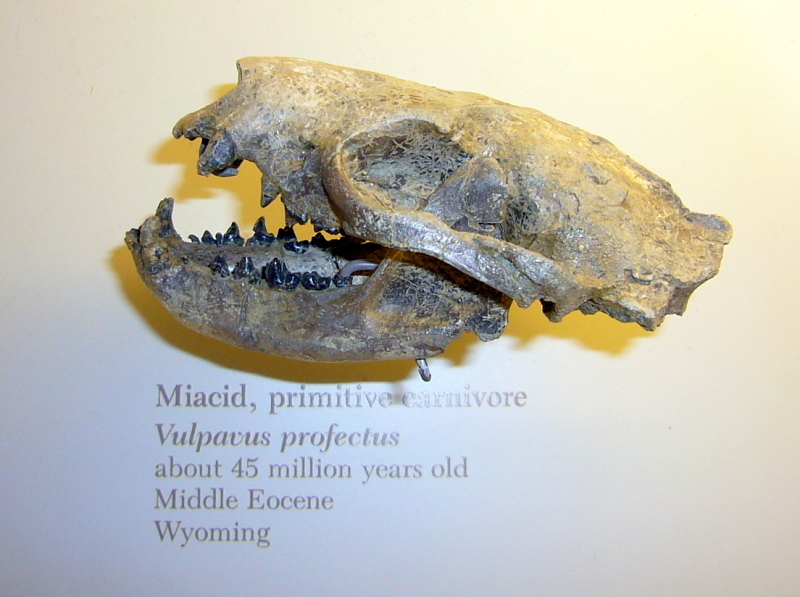|
Vassacyon
''Vassacyon'' is an extinct genus of Miacidae. It contains two species; ''Vassacyon promicrodon'' and ''Vassacyon bowni''. It is considered the largest of the early Eocene mammals Mammals () are a group of vertebrate animals constituting the class Mammalia (), characterized by the presence of mammary glands which in females produce milk for feeding (nursing) their young, a neocortex (a region of the brain), fur o .... Notes References *Flynn, J.J., 1998. Early Cenozoic Carnivora ("Miacoidea"). pp. 110–123 in C.M. Janis, K.M. Scott, and L.L. Jacobs (eds.) ''Evolution of Tertiary Mammals of North America. Volume 1: Terrestrial Carnivores, Ungulates, and Ungulatelike Mammals.'' Cambridge University Press, Cambridge. *zipcodezoo.com [...More Info...] [...Related Items...] OR: [Wikipedia] [Google] [Baidu] |
Miacids
Miacids are extinct primitive carnivoramorphans within the family Miacidae that lived during the Paleocene and Eocene epochs, about 62–34 million years ago. Miacids existed for approximately . Miacids are thought to have evolved into the modern carnivorous mammals of the order Carnivora. They were small carnivores, superficially marten-like or civet-like with long, lithe bodies and long tails. Some species were arboreal, while others lived on the ground. They probably fed on invertebrates, lizards, birds, and smaller mammals like shrews and opossums. Their teeth and skulls show that the miacids were less developed than modern carnivorans. They had carnivoran-type carnassials, but lacked fully ossified auditory bullae (rounded protrusions). Classification Miacidae as traditionally conceived is not a monophyletic group; it is a paraphyletic array of stem taxa. Traditionally, Miacidae and Viverravidae had been classified in a superfamily, Miacoidea. Today, Carnivora ... [...More Info...] [...Related Items...] OR: [Wikipedia] [Google] [Baidu] |
Miacidae
Miacids are extinct primitive carnivoramorphans within the family Miacidae that lived during the Paleocene and Eocene epochs, about 62–34 million years ago. Miacids existed for approximately . Miacids are thought to have evolved into the modern carnivorous mammals of the order Carnivora. They were small carnivores, superficially marten-like or civet-like with long, lithe bodies and long tails. Some species were arboreal, while others lived on the ground. They probably fed on invertebrates, lizards, birds, and smaller mammals like shrews and opossums. Their teeth and skulls show that the miacids were less developed than modern carnivorans. They had carnivoran-type carnassials, but lacked fully ossified auditory bullae (rounded protrusions). Classification Miacidae as traditionally conceived is not a monophyletic group; it is a paraphyletic array of stem taxa. Traditionally, Miacidae and Viverravidae had been classified in a superfamily, Miacoidea. Today, Carnivora a ... [...More Info...] [...Related Items...] OR: [Wikipedia] [Google] [Baidu] |
Eocene
The Eocene ( ) Epoch is a geological epoch (geology), epoch that lasted from about 56 to 33.9 million years ago (mya). It is the second epoch of the Paleogene Period (geology), Period in the modern Cenozoic Era (geology), Era. The name ''Eocene'' comes from the Ancient Greek (''ēṓs'', "dawn") and (''kainós'', "new") and refers to the "dawn" of modern ('new') fauna that appeared during the epoch. The Eocene spans the time from the end of the Paleocene Epoch to the beginning of the Oligocene Epoch. The start of the Eocene is marked by a brief period in which the concentration of the carbon isotope Carbon-13, 13C in the atmosphere was exceptionally low in comparison with the more common isotope Carbon-12, 12C. The end is set at a major extinction event called the ''Grande Coupure'' (the "Great Break" in continuity) or the Eocene–Oligocene extinction event, which may be related to the impact of one or more large bolides in Popigai impact structure, Siberia and in what is now ... [...More Info...] [...Related Items...] OR: [Wikipedia] [Google] [Baidu] |
William Diller Matthew
William Diller Matthew Royal Society, FRS (February 19, 1871 – September 24, 1930) was a vertebrate paleontologist who worked primarily on mammal fossils, although he also published a few early papers on mineralogy, petrological geology, one on botany, one on trilobites, and he described ''Tetraceratops insignis'', which was much later suggested to be the oldest known (Cisuralian, Early Permian) therapsid. Matthew was born in Saint John, New Brunswick, Saint John, New Brunswick, the son of George Frederic Matthew and Katherine (Diller) Matthew. His father was an amateur geologist and paleontologist who instilled his son with an abiding interest in the earth sciences. Matthew received an A.B. at the University of New Brunswick in 1889 and then earned his Ph.D. at Columbia University in 1894. Matthew was curator of the American Museum of Natural History from the mid-1890s to 1927, and director of the University of California Museum of Paleontology from 1927 to 1930. He was the fat ... [...More Info...] [...Related Items...] OR: [Wikipedia] [Google] [Baidu] |
Extinct
Extinction is the termination of a kind of organism or of a group of kinds (taxon), usually a species. The moment of extinction is generally considered to be the death of the last individual of the species, although the capacity to breed and recover may have been lost before this point. Because a species' potential range may be very large, determining this moment is difficult, and is usually done retrospectively. This difficulty leads to phenomena such as Lazarus taxa, where a species presumed extinct abruptly "reappears" (typically in the fossil record) after a period of apparent absence. More than 99% of all species that ever lived on Earth, amounting to over five billion species, are estimated to have died out. It is estimated that there are currently around 8.7 million species of eukaryote globally, and possibly many times more if microorganisms, like bacteria, are included. Notable extinct animal species include non-avian dinosaurs, saber-toothed cats, dodos, m ... [...More Info...] [...Related Items...] OR: [Wikipedia] [Google] [Baidu] |
Genus
Genus ( plural genera ) is a taxonomic rank used in the biological classification of extant taxon, living and fossil organisms as well as Virus classification#ICTV classification, viruses. In the hierarchy of biological classification, genus comes above species and below family (taxonomy), family. In binomial nomenclature, the genus name forms the first part of the binomial species name for each species within the genus. :E.g. ''Panthera leo'' (lion) and ''Panthera onca'' (jaguar) are two species within the genus ''Panthera''. ''Panthera'' is a genus within the family Felidae. The composition of a genus is determined by taxonomy (biology), taxonomists. The standards for genus classification are not strictly codified, so different authorities often produce different classifications for genera. There are some general practices used, however, including the idea that a newly defined genus should fulfill these three criteria to be descriptively useful: # monophyly – all descendants ... [...More Info...] [...Related Items...] OR: [Wikipedia] [Google] [Baidu] |
Species
In biology, a species is the basic unit of classification and a taxonomic rank of an organism, as well as a unit of biodiversity. A species is often defined as the largest group of organisms in which any two individuals of the appropriate sexes or mating types can produce fertile offspring, typically by sexual reproduction. Other ways of defining species include their karyotype, DNA sequence, morphology, behaviour or ecological niche. In addition, paleontologists use the concept of the chronospecies since fossil reproduction cannot be examined. The most recent rigorous estimate for the total number of species of eukaryotes is between 8 and 8.7 million. However, only about 14% of these had been described by 2011. All species (except viruses) are given a two-part name, a "binomial". The first part of a binomial is the genus to which the species belongs. The second part is called the specific name or the specific epithet (in botanical nomenclature, also sometimes i ... [...More Info...] [...Related Items...] OR: [Wikipedia] [Google] [Baidu] |
Mammals
Mammals () are a group of vertebrate animals constituting the class Mammalia (), characterized by the presence of mammary glands which in females produce milk for feeding (nursing) their young, a neocortex (a region of the brain), fur or hair, and three middle ear bones. These characteristics distinguish them from reptiles (including birds) from which they diverged in the Carboniferous, over 300 million years ago. Around 6,400 extant species of mammals have been described divided into 29 orders. The largest orders, in terms of number of species, are the rodents, bats, and Eulipotyphla (hedgehogs, moles, shrews, and others). The next three are the Primates (including humans, apes, monkeys, and others), the Artiodactyla ( cetaceans and even-toed ungulates), and the Carnivora (cats, dogs, seals, and others). In terms of cladistics, which reflects evolutionary history, mammals are the only living members of the Synapsida (synapsids); this clade, together with Saur ... [...More Info...] [...Related Items...] OR: [Wikipedia] [Google] [Baidu] |
Eocene Mammals Of North America
The Eocene ( ) Epoch is a geological epoch that lasted from about 56 to 33.9 million years ago (mya). It is the second epoch of the Paleogene Period in the modern Cenozoic Era. The name ''Eocene'' comes from the Ancient Greek (''ēṓs'', "dawn") and (''kainós'', "new") and refers to the "dawn" of modern ('new') fauna that appeared during the epoch. The Eocene spans the time from the end of the Paleocene Epoch to the beginning of the Oligocene Epoch. The start of the Eocene is marked by a brief period in which the concentration of the carbon isotope 13C in the atmosphere was exceptionally low in comparison with the more common isotope 12C. The end is set at a major extinction event called the ''Grande Coupure'' (the "Great Break" in continuity) or the Eocene–Oligocene extinction event, which may be related to the impact of one or more large bolides in Siberia and in what is now Chesapeake Bay. As with other geologic periods, the strata that define the start and end of the ... [...More Info...] [...Related Items...] OR: [Wikipedia] [Google] [Baidu] |
Eocene Carnivorans
The Eocene ( ) Epoch is a geological epoch that lasted from about 56 to 33.9 million years ago (mya). It is the second epoch of the Paleogene Period in the modern Cenozoic Era. The name ''Eocene'' comes from the Ancient Greek (''ēṓs'', "dawn") and (''kainós'', "new") and refers to the "dawn" of modern ('new') fauna that appeared during the epoch. The Eocene spans the time from the end of the Paleocene Epoch to the beginning of the Oligocene Epoch. The start of the Eocene is marked by a brief period in which the concentration of the carbon isotope 13C in the atmosphere was exceptionally low in comparison with the more common isotope 12C. The end is set at a major extinction event called the ''Grande Coupure'' (the "Great Break" in continuity) or the Eocene–Oligocene extinction event, which may be related to the impact of one or more large bolides in Siberia and in what is now Chesapeake Bay. As with other geologic periods, the strata that define the start and end of the ... [...More Info...] [...Related Items...] OR: [Wikipedia] [Google] [Baidu] |
Prehistoric Placental Genera
Prehistory, also known as pre-literary history, is the period of human history between the use of the first stone tools by hominins 3.3 million years ago and the beginning of recorded history with the invention of writing systems. The use of symbols, marks, and images appears very early among humans, but the earliest known writing systems appeared 5000 years ago. It took thousands of years for writing systems to be widely adopted, with writing spreading to almost all cultures by the 19th century. The end of prehistory therefore came at very different times in different places, and the term is less often used in discussing societies where prehistory ended relatively recently. In the early Bronze Age, Sumer in Mesopotamia, the Indus Valley Civilisation, and ancient Egypt were the first civilizations to develop their own scripts and to keep historical records, with their neighbors following. Most other civilizations reached the end of prehistory during the following Iron Age. T ... [...More Info...] [...Related Items...] OR: [Wikipedia] [Google] [Baidu] |



.jpg)



